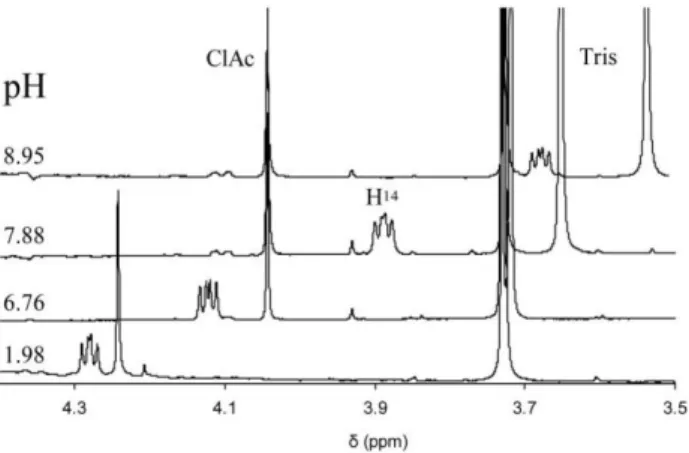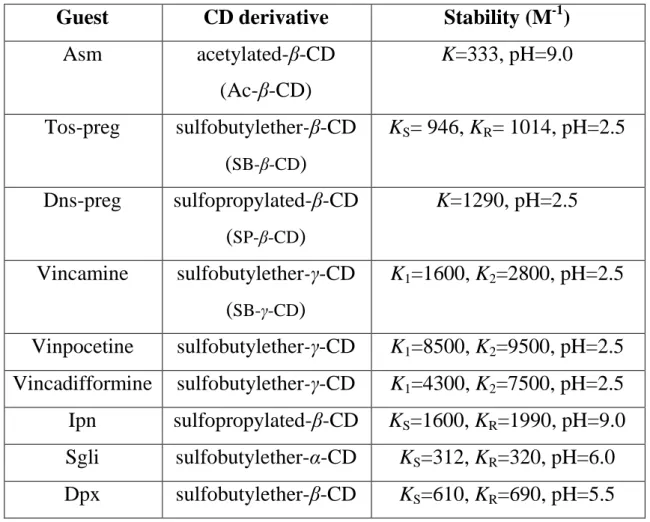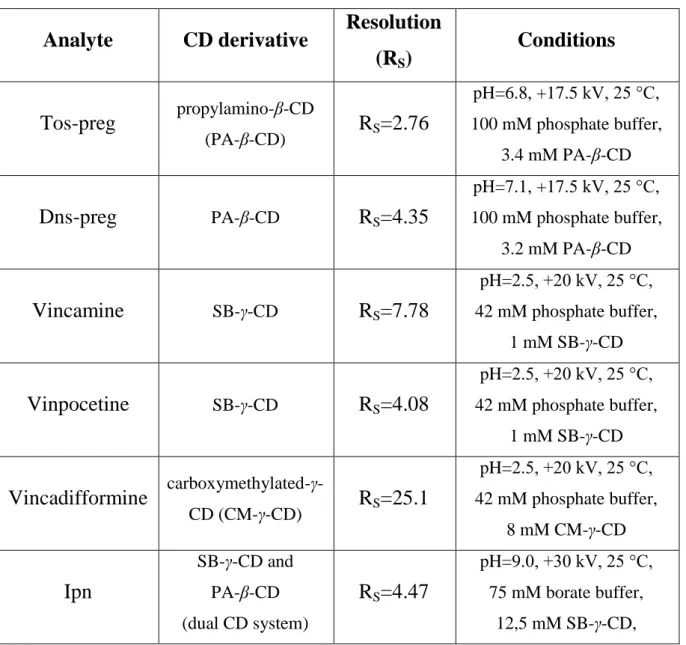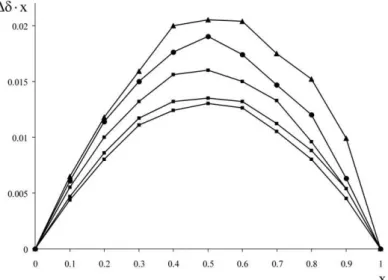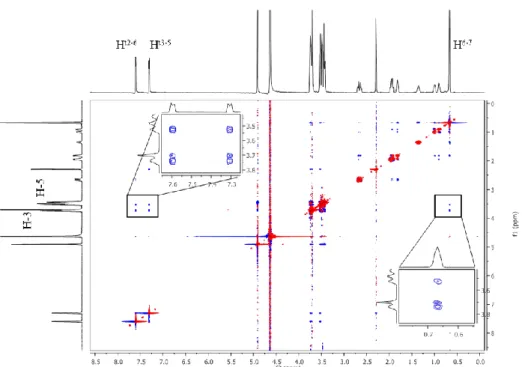Characterization of various cyclodextrin complexes in terms of complex stability and
enantioseparation
PhD Thesis
Tamás Sohajda
Semmelweis University
School of PhD Studies, Pharmaceutical Sciences
Supervisor: Béla Noszál Ph. D., D. Sc.
Reviewers: Ágnes Barczáné Buvári Ph. D., C.Sc.
Tamás Tábi Ph. D.
Chair of comprehensive exam committee: Zoltán Vincze Ph. D., C. Sc.
Members of comprehensive exam committee: Pál Perjési Ph. D., C. Sc.
Huba Kalász Ph. D., D. Sc.
Budapest 2012
1 Introduction
As living organisms are basically chiral entities, optical isomers – including enantiomers – may have different biological effect on them despite their identical constitution. Therefore, synthesis of enantiopure drugs and chiral separation and characterization of the enantiomers are essential requirements of pharmacopoeias. Any contamination over 0.1 % - including enantiomeric impurities - must be determined according to the regulation.
In the chiral recognition process the interacting species has to be compatible on physical, chemical and spatial bases as well. The complexity of the interactions makes it particularly difficult to predict the success of the enantioseparation. Hence, the main purpose of my research – considering the scientific challenge and practical needs – was the development of several enantioseparation methods with capillary electrophoresis (CE) supported by nuclear magnetic resonance (NMR) spectroscopy.
The successful separation of enantiomers with CE needs the application of chiral selectors. The most frequently used chiral additives are the family of cyclodextrin (CDs) thanks to their great effectiveness in this application. During the chiral recognition process diastereomeric inclusion complexes are formed, enforced by secondary chemical bonds between host and guest. The complexation alters the physico-chemical properties of the analyte e.g. enhances its stability against oxidation or photochemical degradation, enhances its solubility or moderates its side-effects. Bearing these advantageous properties, cyclodextrins are widely used in the pharmaceutical- and food industry and also in analytical chemistry.
The main aims of my PhD work have been the investigation of the stability of CD complexes, development of fast and robust capillary electrophoretic methods for the separation of various drug enantiomers and the investigation of the molecular interactions underlying the separation process. As analytes, aspartame (Asm), the tosylated and dansylated derivatives of pregabalin (Tos-
preg and Dns-preg), three vinca alkaloids (vincamine, vinpocetine and vincadifformine), imperanene (Ipn), sitagliptin (Sgli) and dapoxetine (Dpx) were chosen. The separation of most enantiomers was carried out with capillary electrophoresis for the first time. To enhance the resolution, the crucial parameters of the separations were optimized. Moreover, the separation of Dpx enantiomers was validated according to ICH guidelines. A great emphasis was laid on the investigation of the complexes with an independent technique (NMR) as well. The stability constants and stoichiometries of several inclusion complexes were determined with NMR titrations and the three-dimensional structures of the associates were elucidated with 2D NMR sequences as well.
2 Aims
Cyclodextrin complexation of several pharmaceutically relevant compounds (aspartame, pregabalins, vinca alkaloids, sitagliptin, imperanene, dapoxetine) was investigated with capillary electrophoresis and nuclear magnetic resonance spectroscopy.
The protonation state of a compound greatly affects both its behavior in the human body and its affinity towards cyclodextrin derivatives. One of our aims was the acid-base profiling of the molecules via CE-pH and NMR-pH titration, thus the complexation properties of the various protonation isomers could be investigated.
The determination of stability constants of several analyte-CD complexes with mostly CE and in some cases NMR spectroscopy was among our primary objectives as well.
We were determined to develop fast, robust and highly selective capillary electrophoretic methods for the separation of pregabalin, vinca alkaloid, sitagliptin, imperanene and dapoxetine enantiomers. The validation of the enantioseparating method for dapoxetine enantiomers according to actual ICH guidelines was a main objective as well.
Finally, we aimed to determine the stoichiometry and structure of the inclusion complexes using NMR spectroscopy.
3 Methods
3.1 Determination of dissociation constants
The acid-base profiling of aspartame and sitagliptin was carried out with NMR-titration, which was supplemented with CE-pH titration for the latter. The dissociation constants of Tos-preg and Dns-preg pregabalin derivatives were determined with CE-pH titration.
The protonation equilibria of Asm were examined using 1H NMR-pH titration with in situ pH measurement; while for Sgli the pH was determined with calibrated pH meter reading. Both titrations were carried out with the ionic strength and the analysis temperature kept constant (0.15 M – NaCl, 25.0 ± 0.1
°C). As solvents H2O/D2O 9/1 was used with an inner reference of DSS (δ=0.000 ppm). As in situ indicators chloroacetic acid (ClAc), acetic acid, imidazole and Tris were applied. The pH belonging to each spectrum was calculated from the actual chemical shift of the appropriate indicator. For H2O signal suppression the presaturation and dpfgse_water standard NMR sequences were used. The NMR-pH datasets were evaluated with the OPIUM computer program, the spectra were processed with Mestre-C and MestreNova 5.3.1-4825 softwares.
The acid-base profiling of Tos-preg, Dns-preg and Sgli was carried out with capillary electrophoresis. All CE experiments were performed on a 3DCE instrument (Agilent Technologies), equipped with a photodiode array detector and the HP3D CE Chemstation software for data handling. An untreated fused- silica capillary (50 μm id, 64.5 cm total, 56 cm effective length) was purchased from Agilent. Both tray and capillary were thermostated at 25°C and +30 kV voltage was applied. The samples were injected hydrodynamically (50 mbar, 4 s), the samples were run in triplicate and as EOF marker DMSO was used through the study.
For the determination of dissociation constants effective mobility values (ieff ) were calculated based on system and analysis parameters:
EOF i
t eff eff
i U t t
l
l · 1 1
where leff, lt, U, ti and tEOF stand for the effective and total length of the capillary, the applied voltage and the migration times of the analyte and EOF marker, respectively.
The titration curves were obtained displaying effective mobility as a function of pH. The titration points were fitted applying the following equitation:
a
a
pK pH A HA
eff pK pH
10 1 10
The required values of pKa, μA and μHA were calculated with the OPIUM computer program from μeff-pH datasets.
3.2 Investigation of complex stability and enantioseparation
Capillary electrophoresis is an eminent technique for the investigation of both the stability of inclusion complexes and chiral separating potential of cyclodextrins. Determination of complex stability was carried out with all the applied guests using numerous CDs, while enantioseparations were performed in all cases but for aspartame.
All CE experiments were carried out on the same equipment using identical capillary at and experiments we run at the same temperature, applied voltage and injection as described in section 3.1.UV detection was performed at 200, 215, 220, 225 and 230 nm and samples were run in triplicate. As EOF marker DMSO was used in all cases.
Stabilities of the inclusion complexes were investigated mostly at one, for amphoteric compounds at more pH values with a great number of CDs (varying from 17 to 29). During the investigation of the average stability constants the samples were run applying an increasing CD concentration in the BGE (from 5
through 50 mM), and the effective mobility values were calculated afterwards.
The stability constants were determined graphically according to the x- reciprocal method.
For the characterization of chiral selectivity, the resolution value (RS) was used calculated according to the following equation:
2 1
S
1 2
(t t )
R 2
w w
where t1 and t2 stand for the migration times, while w1 and w2 for the extrapolated peak width at baseline of the enantiomers.
Identification of the enantiomers was carried out by spiking the samples with enantiopure analytes.
3.3 Determination of stoichiometry and three-dimensional structure Besides investigation of complex stability, NMR spectroscopy is also an eminent tool for the determination of average complex stoichiometry. These measurements were carried out with the application of the method of continuous variation (Job’s method) using 1H NMR and in case of sitagliptin also 19F NMR titrations. During all experiments H2O/D2O 9/1 was used as solvent and water signal was suppressed using presaturation sequence. Ionic strength and temperature were kept constant (I=0.15 M – NaCl, T=25.0 ± 0.1 ºC). As inner references MeOH (δ=3.300 ppm) and for 19F measurements NaF (δ=-122.0 ppm) were used. 19F experiments were carried out on a Varian Mercury Plus equipment (400 MHz) in the Department of Organic Chemistry, Semmelweis University.
To explore the structure of the inclusion complexes 2D ROESY NMR experiments were carried out in pure D2O. The structure of several CD complexes encapsulating aspartame, pregabalin derivatives, vinca alkaloids, imperanene and sitagliptin were elucidated.
4 Results
4.1 Determination of dissociation constants
The two protonation steps of aspartame (for one carboxylic and one primary amino group) were determined with 1H NMR titration in a single NMR tube in H2O/D2O 9/1, containing also pH-monitoring indicator molecules. The pH belonging to each spectrum was calculated in situ from the actual chemical shift of the appropriate indicator using a rearranged form of the Henderson- Hasselbalch equation:
obs
Ind HInd
Ind obs
Ind Ind
pH log K log
The logKInd indicator protonation constants and limiting chemical shifts (δInd and δHInd) were determined in separate experiments. The protonation constants (logK1=7.83 and logK2=2.96) were determined based on the chemical shifts of the guest protons and the actual pH. NMR-pH datasets were evaluated with the OPIUM computer program. Changes in chemical shift of H14 Asm proton are depicted in Figure 1 at different pH values.
Figure 1. Chemical shift changes of H14 Asm proton caused by differences in solvent pH.
The acid-base equilibrium of Sgli was characterized with CE and NMR as well. Based on the former, the dissociation constant of the Sgli amino group was calculated to be pKa=7.61, which is in good correspondence with the result of
the NMR-pH titration (pKa=8.03) considering the differences in the experimental parameters.
CE-pH titration was carried out for the acid-base profiling of both pregabalin derivatives. The tosylated derivative has a carboxylic function, while Dns-preg also possesses a tertiary amino group. The overlapping dissociation steps of the diprotic Dns-preg correspond to pKa1=3.47 and pKa2=4.67, while for Tos-preg pKa=4.75 was determined.
4.2 Investigation of complex stability and enantioseparation
Complex stabilities were investigated with numerous cyclodextrins for each analyte. Table 1 contains the inclusion complexes of particular guest molecules along with constants of highest stabilities.
Table 1. CD-analyte complexes of highest stability along with the average stability constant determined with CE.
Guest CD derivative Stability (M-1)
Asm acetylated-β-CD
(Ac-β-CD)
K=333, pH=9.0
Tos-preg sulfobutylether-β-CD (SB-β-CD)
KS= 946, KR= 1014, pH=2.5
Dns-preg sulfopropylated-β-CD (SP-β-CD)
K=1290, pH=2.5
Vincamine sulfobutylether-γ-CD (SB-γ-CD)
K1=1600, K2=2800, pH=2.5
Vinpocetine sulfobutylether-γ-CD K1=8500, K2=9500, pH=2.5 Vincadifformine sulfobutylether-γ-CD K1=4300, K2=7500, pH=2.5 Ipn sulfopropylated-β-CD KS=1600, KR=1990, pH=9.0 Sgli sulfobutylether-α-CD KS=312, KR=320, pH=6.0 Dpx sulfobutylether-β-CD KS=610, KR=690, pH=5.5
Cyclodextrins were tested as chiral selectors for all analytes but aspartame.
The separations were optimized in terms of cyclodextrin type and concentration, buffer type and concentration, pH, capillary temperature, applied voltage and organic additive concentration of the BGE. As optimization method, in general the single variation method and for Dpx the orthogonal experimental design was applied. In case single CD systems failed to provide sufficiently high resolution, separation potential of dual CD systems were thoroughly investigated. In Table 2 the optimized enantioseparations are listed along with the achieved resolution values and experimental parameters of the methods.
Table 2. Optimized separations for the analyte enantiomers with the resolution values and experimental parameters displayed.
Analyte CD derivative Resolution
(RS) Conditions
Tos-preg propylamino-β-CD
(PA-β-CD) RS=2.76
pH=6.8, +17.5 kV, 25 °C, 100 mM phosphate buffer,
3.4 mM PA-β-CD
Dns-preg PA-β-CD RS=4.35
pH=7.1, +17.5 kV, 25 °C, 100 mM phosphate buffer,
3.2 mM PA-β-CD
Vincamine SB-γ-CD RS=7.78
pH=2.5, +20 kV, 25 °C, 42 mM phosphate buffer,
1 mM SB-γ-CD
Vinpocetine SB-γ-CD RS=4.08
pH=2.5, +20 kV, 25 °C, 42 mM phosphate buffer,
1 mM SB-γ-CD
Vincadifformine carboxymethylated-γ-
CD (CM-γ-CD) RS=25.1
pH=2.5, +20 kV, 25 °C, 42 mM phosphate buffer,
8 mM CM-γ-CD
Ipn
SB-γ-CD and PA-β-CD (dual CD system)
RS=4.47
pH=9.0, +30 kV, 25 °C, 75 mM borate buffer,
12,5 mM SB-γ-CD,
10 mM PA-β-CD
Sgli SB-β-CD and β-CD
(dual CD system) RS=2.24
pH=4.4, +30 kV, 10 °C, 40 mM phosphate buffer,
5 mM SB-β-CD, 5 mM β-CD
Dpx methylated-γ-CD
(RAMEG-CD) RS=7.01
pH=4.5, +15 kV, 15 °C, 70 mM phosphate buffer,
3 mM RAMEG-CD, 20 v/v% MeOH
The method developed for the separation of Dpx enantiomers was validated according to the ICH (International Conference of Harmonization) guidelines. During the validation process, the repeatability, precision, linearity range, accuracy and robustness of the method were tested and limit of detection (LOD) and limit of quantification (LOQ) were determined.
4.3 Determination of stoichiometry and three-dimensional structure The average stoichiometries of the complexes were determined applying the method of continuous variation with 1H NMR titrations for each analyte but Asm and Dpx. As Sgli contains flour atoms as well, additional 19F experiments were carried out to confirm the results. Evaluation of data was carried out by plotting the chemical shift displacements weighted with the actual molar ratio (Δδ·x) as a function of the molar ratio as depicted in Figure 2.
Figure 2. Job plots derived from the 1H NMR titration of Tos-preg (square) and Dns-preg (triangle) with β-CD (square).
The maximum of the resulting Job’s plots indicate the binding stoichiometry of the guest and the host. All the investigated complexes had a maximum at 0.5 suggesting a 1:1 average stoichiometry.
The three-dimensional structures of the inclusion complexes were investigated with 2D ROESY NMR experiments. As intermolecular NOEs between analyte and cyclodextrin protons directly involved in the host-guest interaction are detected as cross-peaks, this technique enables the determination of the inclusion depth, direction and the participating moieties. Regarding the complexation, the inner cavity CD protons (H-3 and H-5) have an essential role in the analysis. The cross-peaks between CD and guest signals indicate the spatial proximity of these protons as shown in Figure 3. ROESY experiments were carried out for every guest molecule but Dpx, in most case with more than one CD derivative.
Figure 3. The 2D ROESY spectrum of a Tos-preg/β-CD complex (5-5 mM) (D2O, 300 ms mixing time) displaying the cross-peaks between inner cavity CD (H-3 and H-5) and aromatic
(Ht2-6, Ht3-5) and dimethyl (H6-7) Tos-preg protons.
Structures of Asm-β-CD; β-, γ- and PA-β-CD complexes of both pregabalin derivatives; Sgli-β- and SB-β-CD and Ipn-β-, hydroxypropylated(HP)-β- and SB-γ-CD complexes were also elucidated based on ROESY spectra. For vinca alkaloids the underlying evidences of cavity size dependent and substituent dependent migration order reversals were investigated on vinpocetine-HP-β-CD/HP-γ-CD, vincadifformine-HP-β-CD/HP- γ-CD, vincadifformine-RAMEB-CD/RAMEG-CD (cavity size dependency) and on vinpocetine-HP-β-CD/RAMEB-CD (substituent dependency) samples.
5 Conclusions, novel scientific data
In this study cyclodextrin complexation of nine compounds was investigated and chiral separation methods for eight of them were successfully developed.
The dissociation constants of two pregabalin derivatives were determined with CE-pH titration and the characterization of the amino group of Sgli was carried out with both CE-pH and 1H NMR-pH titrations.
Stabilities of inclusion complexes hosted by numerous cyclodextrins were investigated with capillary electrophoresis and for aspartame and vinca alkaloids also with NMR spectroscopy. Complex stabilities of aspartame associates were determined at three pH values (at alkaline pH for the first time) and the complex of Asm and Ac-β-CD was found to be more stable than all the formerly described ones. Charge-dependent complexation of pregabalin derivatives were examined at four pH values and several highly stable complexes were found.
Complexes with noteworthy high binding constant were discovered for all investigated vinca alkaloids, most of them firstly described in the literature.
Cyclodextrin complexation affinity of sitagliptin, imperanene and dapoxetine guest molecules were investigated for the first time and remarkably stable complexes were found for each analyte.
Chiral separations of the enantiomers were successfully achieved for all analytes with capillary electrophoresis. So far only the alkaloid enantiomers have been separated. Chiral recognitions of pregabalin enantiomers were carried out at all pH values. The separation was afterwards optimized with the single variation method in terms of several experimental parameters (pH, BGE and CD concentration, and applied voltage) for both derivatives with PA-β-CD. Chiral separations of vinca alkaloid enantiomers were successfully fulfilled investigating the cavity size and substituent dependent migration order reversals experienced during the study. Dual cyclodextrin systems were applied for the separations of imperanene and sitagliptin isomers as the single CD systems
failed to provide sufficient resolution. The separation parameters of the Sgli method were optimized with the single variation method in terms of pH, buffer concentration and capillary temperature. A 12.5 mM SB-γ-CD and 10.0 mM PA-β-CD system separated the imperanene enantiomers, while for sitagliptin 5 mM SB-β-CD and 5 mM β-CD was applied. The separation of dapoxetine enantiomers achieved with RAMEG-CD was optimized with the method of orthogonal experimental design for six essential parameters. The method was afterwards validated according to the proper ICH guidelines.
The stoichiometries of the complexes were verified to be 1:1 in all cases (except aspartame and dapoxetine associates) with the method of continuous variation using 1H NMR titration. The experiments were carried out with CDs of great importance based on preliminary stability and chiral separation results. For sitagliptin additional 19F NMR experiments were carried out to confirm the host- guest ratio. The stoichiometries of only Asm- and vinca alkaloid-CD complex have been reported previously.
For the complete characterization of the complexes, the three-dimensional structure was investigated using 2D ROESY NMR spectroscopy for most analytes. Based on these data the direction and depth of inclusions and the moieties participating in the complexation process were identified.
Investigations regarding the spatial structure of the cyclodextrin complexes have so far been reported for aspartame, vinpocetine and molecules containing dansyl moiety.
5 List of personal publications
Publications associated with the thesis
1. Sohajda T, Béni Sz, Varga E, Iványi R, Rácz Á, Szente L, Noszál B. (2009) Characterization of aspartame-cyclodextrin complexation. J Pharm Biomed Anal, 50:
737-745. IF: 2.453
2. Béni Sz, Sohajda T, Neumajer G, Iványi R, Szente L, Noszál B. (2010) Separation and characterization of modified pregabalins in terms of cyclodextrin complexation, using capillary electrophoresis and nuclear magnetic resonance. J Pharm Biomed Anal, 51:
842-852. IF: 2.733
3. Sohajda T, Varga E, Béni Sz, Iványi R, Fejős I, Szente L, Noszál B. (2010) Separation of vinca alkaloid enantiomers by capillary electrophoresis applying cyclodextrin derivatives and characterization of cyclodextrin complexes by nuclear magnetic resonance spectroscopy. J Pharm Biomed Anal, 53: 1258-1266. IF: 2.733 4. Sohajda T, Hu WH, Zeng LL, Li H, Szente L, Noszál B, Béni Sz. (2011) Evaluation of
the interaction between sitagliptin and cyclodextrin derivatives by capillary electrophoresis and nuclear magnetic resonance spectroscopy. Electrophoresis, 32:
2648-2654. IF: 3.569*
5. Sohajda T, Szakács Z, Szente L, Noszál B, Béni Sz. (2012) Chiral recognition of imperanene enantiomers by various cyclodextrins: A capillary electrophoresis and NMR spectroscopy study. Electrophoresis, (accepted for publication). IF: 3.569*
6. Neumajer G, Sohajda T, Darcsi A, Tóth G, Szente L, Noszál B, Béni Sz. (2012) Chiral recognition of dapoxetine enantiomers with methylated-gamma-cyclodextrin: a validated capillary electrophoresis method. J Pharm Biomed Anal, 62: 42-47. IF: 2.733*
Acknowledgements
I wish to express my gratitude to Professor Béla Noszál for his indispensible advices and providing me the opportunity to join the research group of the Department of Pharmaceutical Chemistry at Semmelweis University, Faculty of Pharmacy.
I would like to express my gratefulness to my friend Dr. Szabolcs Béni for his constant support and his helpfulness during all my PhD studies.
I wish to thank Dr. Gábor Neumajer for the synthesis of pregabalin derivatives and András Darcsi undergraduate student (Semmelweis University, Faculty of Pharmacy) for the synthesis of racemic dapoxetine.
I am grateful to Dr. Zoltán Szakács (Gedeon Richter Plc. Spectroscopic Research) for all the invaluable consultations he provided during my studies and the advices he gave regarding the publications.
Furthermore, I would like to thank Dr. Lajos Szente (Cyclolab Ltd.) and Dr. Róbert Iványi for introducing me to the world of cyclodextrins and to Cyclolab Ltd. for providing any cyclodextrin I asked for my research.
I am grateful to Erzsébet Varga (Cyclolab Ltd.) and Ida Fejős undergraduate student (Semmelweis University, Faculty of Pharmacy) for all their help in the investigation of vinca alkaloid-cyclodextrin complexes.
I owe my gratitude to Dr. Zsuzsanna Kovács for her help with the capillary electrophoresis experiments.
I thank Yuichi Kobayashi and coworkers for the synthesis of imperanene, Wen Hui Hu coworkers for the synthesis of sitagliptin and Vicente Gotor Fernández and coworkers for the synthesis of enantiopure dapoxetine and for the provision of the substances.
Many thanks to all my colleagues working at the Department of Inorganic and Analytical Chemistry at Eötvös Loránd University and at the Department of Pharmaceutical Chemistry at Semmelweis University for their everyday help and the inspiring atmosphere.
Finally, I would like to express my gratefulness to my parents for maintaining a safe background and enabling me to concentrate on my studies and to my girlfriend for her patience and understanding.
